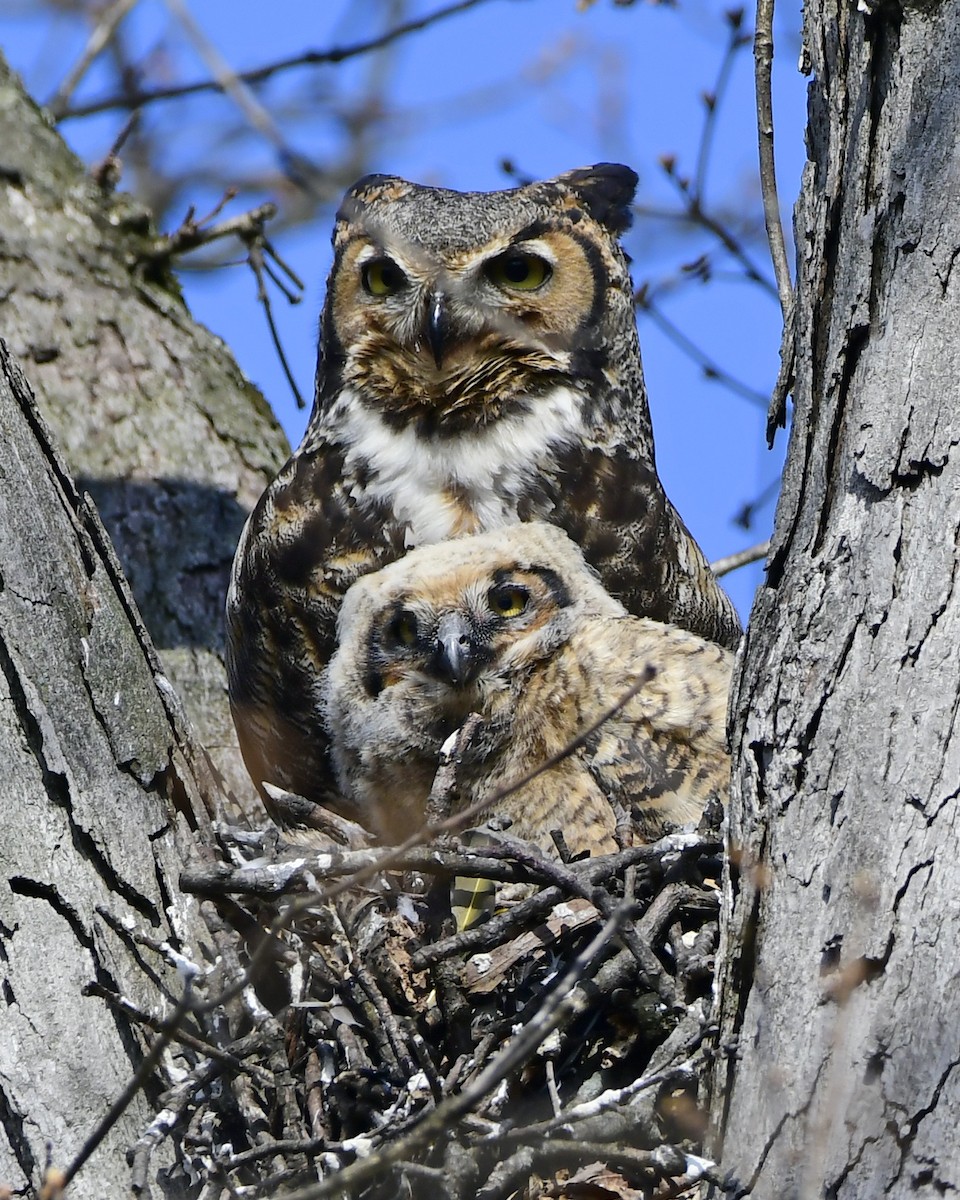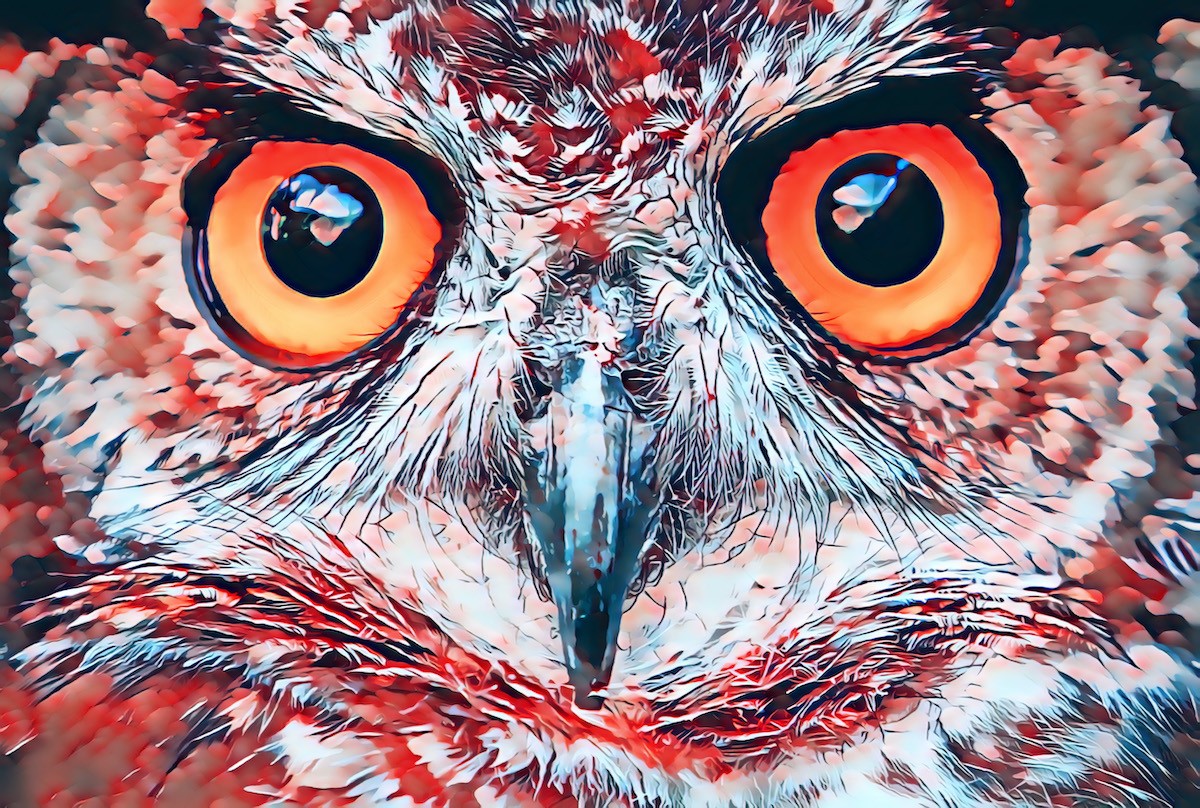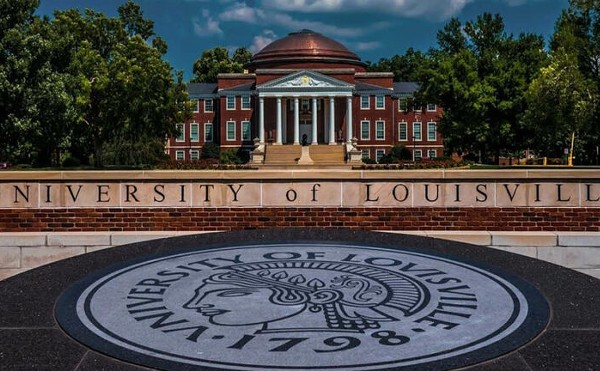On a cloudy evening in early spring, I was walking alone on the trail above Cull Hollow when I heard the great horned owl. Its call was subtle, like wind passing over the lip of a bottle placed at a distance among the trees. It came, near as I could figure, from the hillside across the creek. I paused when rain began to fall and leaned against a black oak, listening. The call seemed plaintive, but more than likely this was only a reflection of my own melancholy cast among the brambles. Soft as a breath, the call of the great horned owl is not as piercing as that of the other owls, neither the screech, the barred, nor the saw-whet. It is soothing, rather. Were there a roar of traffic, or even fast-flowing water, the song would be submerged in the sound, lost. It is incredible to think how much we miss because of such common distractions.
I stood beside the tree until the rain stopped, then walked on, following the trail up the ridge and back towards the car, parked beside some springs at Guerilla Hollow. But though my feet were tethered to the trail, my attention drifted out towards the owl. I listened for it the entire way, stopping each time I heard it. I suppose I hoped to catch a sight of the owl in flight. I saw nothing, though I scanned the gathering dark. The crepuscular hour descended.
I was south of the city, in the Bernheim Research Forest. At more than 16,000 acres, both the research forest and the contiguous arboretum naturally provide prime habitat for such a bird as the owl. Food is abundant, of course: squirrels, cottontails, chipmunks, mice and voles. Opportune nesting sites allow for security. The territory is vast, and beyond Bernheim’s boundaries, there are yet more fields, more forest tracts. But like so many raptors — eagles, hawks and falcons among them — the great horned owl is likewise to be found within the city limits, in the core of Louisville itself.
Only days before, I had visited two nesting sites of the great horned owl, one in Cherokee Park and the other in Cave Hill Cemetery. I had taken my daughter to see both, and I was disappointed she could not be there with me in that moment on the ridge in Bernheim. Last summer, we discovered a great horned owl pair in the Beargrass Creek State Nature Preserve adjacent to the Louisville Nature Center; we heard them as we walked uphill through neighboring Joe Creason Park at the edge of the woods. I do not know if a nest exists on that tract, or where. By the time I arrived in Bernheim, it interested me, of course, that the great horned owl was asserting itself in my daily reality, in my mind, and had been for nearly a year.
Last year, I became aware of the numerous barred owl nests throughout Cherokee Park, as well. I was one among many in that regard. The barred owls became an attraction, especially because their nests hosted owlets. There were, by my count, three nests I was aware of throughout the park: one at the edge of the woods along Cherokee Road and two above Beargrass Creek. This spring, the pairs of great horned owls in both Cherokee and Cave Hill came to everyone’s attention, with social media playing a role. A few visitors posted photographs. In good weather, the posts drew small crowds.
The fascination of onlookers I have seen beneath these nests — photographers, birders, even parents bringing their children — is palpable. There is something in the owl that touches a deep part of us, and the fact of owls nesting so close to us encourages a new relationship to the wild and what is, at heart, a symbol. We have known the owl our whole lives, through fables, through nature programs, but we may never have seen one at such proximity. To be able to do so in the city is fortunate.
A simple and summative sentence that one man uttered beneath the beech trees in the park was exemplative of this interest: “I love owls,” he said, his eyes plying the canopy for the dark silhouettes of the birds. I wanted my daughter to see them, too. I thought she might come to love them in the same way I did. In any regard, the owls are an indication of many things. The health of a habitat. Climate change. Even our own intimacy with the landscape.

***
Bubo virginianus, the great horned owl, is the quintessential owl of North America. The largest of the owls on the continent, it is mythic in stature. It would be no surprise that when an owl comes to mind, it would be this one, with its prominent tufts — commonly mistaken, of course, for “ears” — and its bold yellow eyes, that would announce itself. Its stare is described as “intimidating,” and belies, at least in our imagination, the ferocity attributed to the great horned owl, a raptor weighing only three pounds but capable of taking down large raptors itself, like osprey or peregrine falcons. Its talons are formidable and are used to crush the spines of its prey with a force reputedly as much as 500 pounds per square inch, its grip perhaps ten times as strong as that of a human hand.The “tiger owl,” as it has been called, is found throughout North America. They hunt at night, sometimes at dusk. Their night vision is superb, their hearing impeccable. In addition to the usual prey, this owl can hunt skunks, ducks, opossums, frogs, snakes, even smaller owls.
They are no friend to the crow, who will mob and harass an owl. The crow has every reason to fear the owl, which hunts them.
The great horned owl will begin nesting as early as late winter. These owls will frequently take over the abandoned nest of a larger bird, that of a hawk or a heron or even an eagle, as is the case with the owls in Cave Hill Cemetery, who claimed an abandoned hawk’s nest. They will also nest in the cavities of broken trees — such is the case with the owls in Cherokee Park, nested down in the crotch of a beech. The female will incubate the dull-colored eggs for a period of four to five weeks. Two or three eggs are common. At five weeks, the young will begin to climb the branches, and by 10 weeks they will fly. The parents, both of whom hunt for the young, will continue to feed the brood for several months.
These are mere facts that do little to describe such a creature as the owl. We may understand them, a little. There comes a moment when an owl turns its head — as they famously rotate their heads upon their spines some 270 degrees — to face you. Its eyes grip you both with its gaze and the attendant question that may not even rise until you are far from the woods, waiting at a red light, or lying in bed late at night: What does the owl see in me? What is it thinking?

***
The great horned owl has been with us since the Pleistocene, an era stretching back nearly 3 million years ago. In our mythologies, the owl has been with us for thousands of years at least. In the Western tradition, the owl is associated with Athena, the Greek goddess of wisdom and, later, the Roman goddess Minerva for the same attribute — hence, the owl’s association with wisdom. The Greek outlook on the owl was largely positive, but the Romans, for their part, saw the owl as a harbinger of doom, and they began the tradition of nailing the body of an owl to the door to ward off evil. The custom apparently persisted in parts of Europe until as recent as the 18th century. In the Appalachians, an owl seen during the day has long portended ill luck or, at worst, an early death. Casca, in Shakespeare’s “Julius Caesar,” describes the owl as an omen of death. “Out on you, owls!” shouts Richard III, “nothing but songs of death?” Europeans have carried these ideas across the Atlantic.Among the cultures of Kentucky before the arrival of the whites, the Cherokee esteemed the owls but also deemed them dangerous. The Owl was one of the clans of the Shawnee; their warriors wore owl feathers tucked in their bandanas. Knowing this, we might find a suitable understanding of the owl on this new continent. The more we come to know the owl, one might argue, the more we will have arrived on these shores, and the more we might call this our home.
***
Scientists from the Audubon Society, having used 140 million bird observations and climate models, have determined that at current temperatures, the great horned owl will continue to thrive in the region. However, at an increase of even 1.5 degrees Celsius, this owl will begin to lose range in southern Kentucky, a great deal of Tennessee and large areas of the southern Appalachian Mountains. At twice that temperature increase, more habitat in Kentucky will be lost and, to the south, hundreds of square miles will become uninhabitable. Spring heat waves, the Society notes, can endanger young birds in the nest. Wildfires destroy forest habitat and, if repeated, will prevent recovery.Like many birds, their habitats will expand to the north as huge swaths of land in Canada warm. For now, we have a stable population, and the International Union for Conservation of Nature lists the great horned owl as of “Least Concern.”
By now, this late in the spring, the owlets I have been watching have all flown. The nest of the great horned owls in Cave Hill, empty of fledglings, is set in the crotch of a towering white oak beside the lake. I came upon it unintentionally, while photographing several graves in the area. With the numbers of birders with binoculars at hand, as well as the photographers equipped with tripods and long lenses, it was clear an extraordinary bird was close.
The Rev. Lee Payne Jr. stood along the road with his own camera, answering questions. At the time, the female was largely relegated to the nest, and the owlets would at times peek over the lip of the nest to observe us, curious. The male, he said, often perches in a large pine tree across the lake. One could see the nesting owls without the aid of lenses, though it helped to have them.
In addition to being a chaplain and the security team manager, Payne is the wildlife specialist of Cave Hill Cemetery. There are numerous wild species within the cemetery that he can speak of, many of them birds — buffleheads, wood ducks, red-tailed hawks, cormorants, and Baltimore orioles among others. There are also flying squirrels, foxes, and river otters, and certainly there are prey species within the nearly 300 acres that the cemetery bounds. Payne told me he has been watching this pair for six years. The pair nested this year in January; there were two owlets. He estimates that 2,000 people have come to see the birds.
To see the birds clearly makes people happy. Birders, in particular, are eager to share information, and it was here that a woman told me of the great horned Oowls nesting in Cherokee Park, near the bank of Beargrass Creek.
I first visited the nest in Cherokee Park, cradled in the trunk of a large beech tree, with my 11-year-old daughter. She is not especially interested in birds, but I wanted her to see them, if we could. We parked the car at the end of Eastern Parkway and followed the paved path from Baringer Spring along the dry creekbed toward the meadow known as Frisbee Field. At the bottom of the Cochran Hill Road, we turned east toward Beals Branch, crossing the stone bridge over Beargrass Creek. At this point, we entered the woods where we saw several people peering into the crowns of the trees.
A man who had clearly been surveying the place for some time, weeks at least, pointed out the owls in some distant treetops. There was, as well, a juvenile among the small clan. He showed us another beech tree where the owls eat and, beneath it, a collection of owl pellets, bones, and a bloodied rabbit’s foot. The leaves of the underbrush about the trunk were stained white with droppings. I showed my daughter these things.
We climbed the hillside there and went looking for the female, perched in the distance. As we circled around and came down a trail above the water, the owl turned to face us, its gaze unwavering. I gazed at it myself, for a while, until it looked away. I admired its tenacity, its ferocity. I suppose I appreciated its interest in me, too, no matter how short lived.
I would often walk in Cherokee Park in the evenings and, without fail, would stop near the nest. One evening, alone, I saw a single owlet perched resolute at the edge of the nest, fully in view. No one else was about. It watched me. I imagined it curious. In the distance, along the ridge, I heard the distinctive call of the juvenile. It took some time to realize that the female was directly above me. This is the last time I saw any of the great horned owls, though I know they are about. Despite the freeway that runs close to this stretch of the creek, it would be possible, if one was attentive, to hear their breathy call and to see, distinguished from the clumps of squirrel nests scattered in the canopy, their unmistakable silhouette in the failing light of an evening.
***
What my daughter thinks of the owls is not clear. I ask her, but she seems unwilling to articulate beyond simple statements — “It’s cool,” things like that. I’m not disappointed, exactly, but I want her to see more than the owls; I want her to see that her father is interested in them, and, in fact, that numerous people come to see them, sometimes daily. These people carry binoculars and talk with enthusiasm. They share what they know. I want her to see that the birds deserve our regard.It sometimes seems to me that, as a people, we have so little in the way of traditions. We speak of television programs we remember when we were young, of cities we have been to as students, of music we loved as teens. Growing up, my family did not talk about animals as an aspect of our lives until we moved to upstate New York. The house, less than 50 yards from the Chemung River, had a bird feeder, and so we would all sit about the window watching cardinals, blue jays, mourning doves. Deer would sometimes roam into the yard from the river. Woodchucks tunneled under our porch and grazed the grass in the evening.
But to see these animals as something larger, as emblems, like the seasons, of the world, would offer us a common language, a common perspective from which we might measure our lives. The animals are larger than emblems, of course; they are as much personalities as they are mysteries. When we are grieved, we might turn to the animals for their character, for what wisdom they have gathered in their survival over millions of years. We might define the world as something other than ourselves.
To be honest, I also want my daughter to take something of a moment, staring up at the owls and carry it with her when I am gone. I would hope that on some evening, perhaps when she is my age, she might walk to the edge of the woods herself, even in a thin rain and listen for the call that would draw her back in time, to these woods, to this creek, to this time when her father was still young, standing beside her. I want her to remember that I walked into the woods to witness what I loved in this world, marveling, my hand perched on her shoulder and, for a moment, our eyes meeting in the gathering dark.






